Bb12-0
The position of Betelgeuze (*88) on the eastern brink of
the Milky Way river suggested a humid place
→ he should be a Moist One (Ardra):
.jpg)
 |
 |
 |
 |
 |
|
Bb12-41 |
Bb12-42 |
Bb12-43 (504) |
Bb12-44 |
Bb12-45 |
|
Dec 13 (Lucia) |
14 (348) |
15 |
16 |
17 |
|
OCT 10 |
11 (284) |
12 |
13 |
14 |
|
λ
Arae (267.1),
GIRTAB (Seizer) =
κ
Scorpii,
ο
Serpentis (267.6),
DSIBAN (Wolf Pair) =
ψ
Draconis
(267.9)
|
KELB ALRAI (Dog of the Shepherd) =
β
Ophiuchi,
μ Arae (268.1),
KEW HO (Nine Rivers) =
μ
Herculis
(268.6),
η
Pavonis (268.7),
APOLLYON =
ι
Scorpii
(268.9) |
MULIPHEN (Oaths) =
γ
Ophiuchi
(269.0),
BASANISMUS = G Scorpii
(269.5),
PHERKARD (Dim One of the Two Calves) =
δ
Ursae Minoris
(269.9) |
PTOLEMY CLUSTER = M7 Scorpii
(270.5),
GRUMIUM (Lower Jaw) =
ξ
Draconis
(270.9) |
RUKBALGETHI GENUBI (Bending Claw) =
θ
Herculis
(271.1),
ξ
Herculis (271.5),
ETAMIN (Head) =
γ
Draconis,
ν
Herculis (271.7),
ν
Ophiuchi (271.8) |
 |
|
June 13 (164) |
14 |
15 |
16 |
17 (168) |
|
MENKAURE
Three Stars-21 (Gibbon)
/
Shur-narkabti-sha-shūtū-6
(Star in the Bull towards the south)
/
ANA-IVA-9 (Pillar of exit)
HEAVENLY GATE =
ζ
Tauri,
ν
Columbae (84.0),
ω
Orionis (84.2),
ALNITAK (Girdle) =
ζ
Orionis,
PHAKT (Phaet) =
α
Columbae
(84.7) |
ο Aurigae (85.8), γ Leporis (85.9)
YANG MUN (α Lupi) |
μ Columbae (86.1),
SAIPH (Sword) = κ Orionis
(86.5), τ Aurigae, ζ Leporis (86.6) |
υ Aurigae (87.1), ν Aurigae (87.2),
WEZN (Weight) = β Columbae,
δ Leporis (87.7),
TZE (Son) = λ Columbae
(87.9) |
Ardra-6 (The Moist One)
/
ANA-VARU-8 (Pillar to sit by)
χ¹
Orionis,
ξ
Aurigae (88.1),
BETELGEUZE =
α
Orionis
(88.3),
ξ
Columbae (88.5),
σ
Columbae (88.7)
ZUBEN ELGENUBI (α Librae) |
|
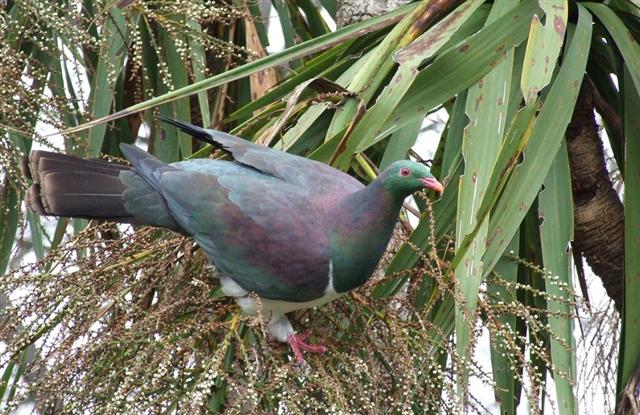
... An oracle reached him from the town of Buto,
which said 'six years only shalt thou live upon this
earth, and in the seventh thou shalt end thy days'.
Mycerinus, indignant, sent an angry message
to the oracle, reproaching the god with his
injustice - 'My father and uncle,' he said 'though
they shut up the temples, took no thought of the
gods and destroyed multitudes of men, nevertheless
enjoyed a long life; I, who am pious, am to die
soon!' There came in reply a second message from the
oracle - 'for this very reason is thy life brought
so quickly to a close - thou hast not done as it
behoved thee ... |
|
'May 17 |
18 |
19 |
20 |
21 (141) |
|
"May 3 |
4 |
5 |
6 |
7 (127) |
|
APRIL 10 |
11 |
12 |
13 |
14 (104) |
|
ki te mauga |
E ariki ra ku ria mauga |
kua rere ia |
ki te mauga |
ko te henua ia kua oti |
|
Riha. Slow, tardy. Mgv.:
ria, id.
Mq.: iá,
id. Ta.: riha,
id. Rihariha:
1. Feeble, cooked too much. 2. Greedy. Mq.:
ihaiha,
gorged, stomach filled to repletion. Churchill.
Oti.
To come to an end; to suffice, to be
enough: ku-oti-á, it is finished; ina kai
oti mo kai, there is not enough to eat;
he-oti á, there isn't anymore left, it's the
last one; it's enough with that. Vanaga. Ta.: 1.
Oti, presage of death. Sa.: oti, to die.
2. To cut. Mq.: koti, oti, id. Sa.:
'oti, id. Ma.: koti, id. Churchill.
According to Metoro this was te henua ia kua oti, which I
guess meant a piece
of Land 'cut off' from the mainland (cfr
Moku-ola).
|
BETELGEUZE
|
177 (→ 6 * 29½) |
265 (→ 365 - 100) |
|
88.3 |
2 * 88.3 |
3 * 88.3 |
|
88 |
176 |
264 |
|
176 * 3 =
528 |
This idea could have been illustrated in how there
was a little henua
piece of land (an islet, motu) separated from the
left main part (air-land-water) of the great glyph picture ending with a 'flipper'
(for moving down in the water) in
Gb7-30 -
where the Full Moon was at the right ascension line of
Arcturus.

... The 'classic' version, however, was
much more detailed: the rope would seem to rise high into
the skies, disappearing from view. The boy would climb the
rope and be lost to view. The magician would call back his
boy assistant, and, on getting no response, become furious.
The magician then armed himself with a knife or sword and
climbed the rope, vanishing too. An argument would be heard,
and then limbs would start falling, presumably cut from the
assistant by the magician. When all the parts of the body,
including the torso, landed on the
ground, the magician would climb down the rope. He would
collect the limbs and put them in a basket, or collect the
limbs in one place and cover them with a cape or blanket.
Soon the boy would appear, restored ... |
Significantly this place corresponded to where the Southern
Claw in Libra culminated at 21h;
... Allen has documented all his star culminations at 21h, which
could be due to an effort of keeping the culminations at their
proper places according to the ancients, 24h (spring equinox) -
21h = 3h = 24h / 8 = 45º. 3h corresponds to 366 / 8 = 45.75 of
my right ascension days and *366 - *46 = *320 (Dramasa,
σ
Octantis) ...
and we can then count *88 + *365 - *224 = 229 (= 506 - 277)
glyphs earlier in order to find the place where the Full
Moon had been at the right ascension line connected with
Zuben Elgenubi. The 8th Tahitian star pillar was the place
to sit (settle) and that was also the meaning of noho:
 |
 |
 |
 |
 |
|
Bb7-32 |
Bb7-33 |
Bb7-34 (277) |
Bb7-35 |
Bb7-36 (700) |
|
i to huki - o to maro |
e tagata - hua era |
e tagata
noho |
ki to manu e |
kua moe koe |
|
Noho. 1. To sit, to stay, to remain,
to live (somewhere), to wait; ka-noho,
you stay! (i.e. 'good-bye', said by the person
leaving). 2. Figuratively: he noho te eve,
to be calm, at peace; he noho te mana'u,
to concentrate on something, to fix one's
attention on; ku-noho á te mana'u o te tagata
ki ruga ki te aga, the man thinks constantly
of his work. Vanaga. Seat, bench, dwelling,
marriage, position, posture, situation, session,
sojourn; to sit, to dwell, to reside, to rest,
to halt, to inhabit;
noho hahatu,
to sit cross-legged;
noho hakahaga,
apathy; noho
heenua, countryman;
noho kaiga,
native; noho
kenu, married;
noho ke noho ke,
to change place;
noho muri,
to stay behind;
noho noa, invariable;
noho opata,
to stand on a cliff;
noho pagaha,
badly placed;
noho pepe, table;
noho tahaga,
bachelor, unmarried;
noho vie,
married, noho no,
apathy, stay-at-home, colonist, idler,
inhabitant, inactive, immobile, settler, lazy,
loiterer.
Hakanoho, to abolish, to rent, to
lease, to enslave, to dissuade, to exclude, to
exempt, to install, to substitute, hostage.
Hakanohohia,
stopped. Nohoga,
seat. Nohoturi,
to kneel, genuflexion.
Nohovaega,
to preside. Churchill. |
|
April 30 (120) |
May 1 (Beltane) |
2 |
3 |
4 |
|
'April 3 (93) |
4 |
5 |
6 |
7 |
|
"March 20 (79) |
21 (0h) |
22 (*1) |
23 |
24 |
|
FEBR 25 (421) |
26 |
27 (58) |
28 |
MARCH 1 |
|
HELIACAL
STARS: |
|
π
Ceti,
ο
Arietis (40.0),
ANGETENAR (Bend in the River) =
τ¹
Eridani,
μ
Ceti (40.2),
RIGHT WING = 39 Arietis
(40.9) |
Bharani-2 (Yoni)
/
Stomach-17 (Pheasant)
π
Arietis (41.2),
MIRAM (Next to the Pleiades) =
η
Persei
(41.3),
BHARANI = 41 Arietis (41.4),
τ²
Eridani,
σ
Arietis (41.7) |
TA LING (Great Mound) = τ Persei (42.4)
*1.0 = *42.4 - *41.4 |
ρ
Arietis (43.0),
GORGONEA SECUNDA =
π
Persei
(43.5),
ACAMAR (End of the River) =
θ
Eridani
(43.6),
ε
Arietis (43.7),
λ
Ceti (43.9)
DENEBOLA (β Leonis) |
MENKAR (The Nose) =
α
Ceti
(44.7) |
|
RIGHT
ASCENSION DAYS AT THE FULL MOON: |
|
Oct 29 (302) |
30 |
31
(Halloween) |
Nov 1 |
2 |
|
'Oct 2 (275) |
3 |
4 |
5 |
6 |
|
"Sept 18 (261) |
19 |
20 |
21 |
22 |
|
AUG 26 (238) |
27 |
28 |
29 |
30 |
|
31 Bootis
(222.0),
YANG MUN (South Gate) =
α
Lupi
(222.1),
RIJL AL AWWA (Foot of the Barker) =
μ
Virginis
(222.5),
ο
Bootis (222.9) |
IZAR (Girdle) =
ε
Bootis
(223.0),
109 Virginis,
α
Apodis (223.3),
μ
Librae (223.8) |
Al Zubānā-14a (Claws)
/
Visakha-16 (Forked)
/
Root-3
(Badger)
ZUBEN ELGENUBI (Southern Claw) =
α
Librae
(224.2),
ξ
Bootis,
ο
Lupi (224.5) |
KOCHAB (Kakkab) = β Ursae Min.
(225.0),
ξ Librae (225.7) |
KE KWAN (Cavalry Officer) =
β Lupi
(226.3),
KE KWAN =
κ
Centauri (226.4), ZUBEN ELAKRIBI (Claw of the
Scorpion) =
δ
Librae
(226.8),
π¹
Oct.
(226.9) |
.jpg) |
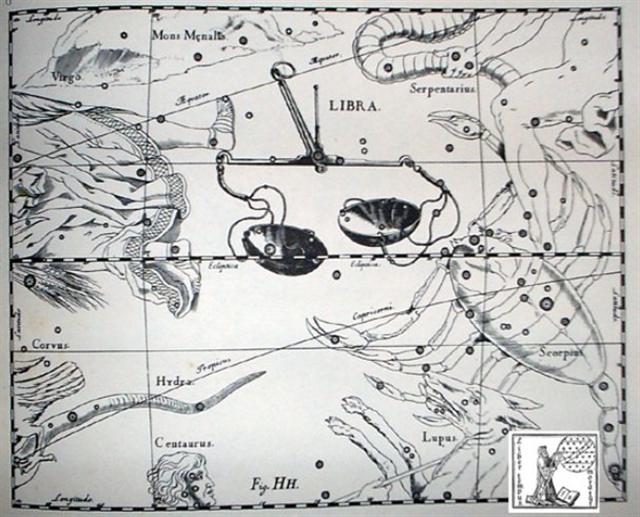
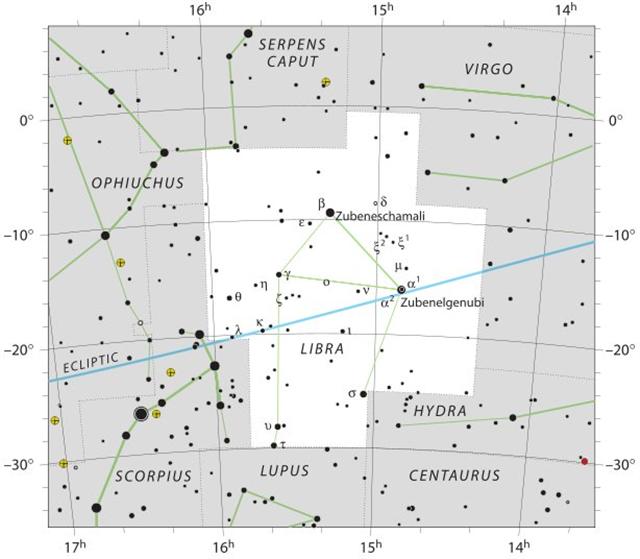

In a way the set of these significant numbers for Betelgeuze could be perceived to correspond to:
|
214 |
314 |
414 |
|
942 = 3 * 314 |
... The Hawaiian woman who was
interviewed chuckled because the
assassination of Captain Cook coincided with the day
we have named All Hearts' Day - when in February
14 (2-14) the war-god Kuu returned to power
...

For instance because 6 * 88 = 528 = 2 * 264 = 88 + 176 +
264 = 942 - 414 (→ Bharani,
*41.4).
|
BETELGEUZE
|
177 (→ 6 * 29½) |
265 (→ 365 - 100) |
|
88.3 |
2 * 88.3 |
3 * 88.3 |
|
88 |
176 |
264 |
|
176 * 3 =
528 |
We should therefore count 528 - 506 (Bb12-45) = 22 → π, and February
18 (414) → Bb1-22
→ Full Moon at 22h
(at the Lucky King, Sad-al-melik, α Aquarii):
... About Carmenta we know from the historian Dionysus
Periergetis that she gave orcales to Hercules and lived
to the age of 110 years. 110 was a canonical number, the
ideal age which every Egyptian wished to reach and the
age at which, for example, the patriarch Joseph died.
The 110 years were made up of twenty-two Etruscan
lustra of five years each; and 110 years composed
the 'cycle' taken over from the Etruscans by the Romans.
At the end of each cycle they corrected irregularities
in the solar calendar by intercalation and held Secular
Games. The secret sense of 22 - sacred numbers were
never chosen haphazardly - is that it is the measure of
the circumference of the circle when the diameter is 7.
This proportion, now known as pi, is no longer a
religious secret; and is used today only as a
rule-of-thumb formula, the real mathematical value of
pi being a decimal figure which nobody has yet been
able work out because it goes on without ever ending, as
22 / 7 does, in a neat recurring sequence
[3.142857142857 ...]. Seven lustra add up to thirty-five
years, and thirty-five at Rome was the age at which a
man was held to reach his prime and might be elected
Consul. (The same age was fixed upon by a
Classically-minded Convention as the earliest at which
an American might be elected President of the United
States.)
...
 |
 |
 |
 |
 |
 |
 |
|
Bb1-22 |
Bb1-23 |
Bb1-24 |
→ 5 * 5 * 5 |
Bb1-26 |
Bb1-27 |
Bb1-28 (449) |
|
eko te manu kua mau - ki to
ahi |
kua haga - te mea ke |
kua hupe |
ma te maitaki |
kua rere te manu |
vae oho |
ku pepepepe te manu |
|
Hupee.
Mucus; hupeehupee, asthma. T Pau.,
Ta.: hupe, mucus. Churchill. Ta.: Hupe,
mucus. (Sa.: isupē,
id.) Ma.: hupe,
id. Churchill. Rhume, air froide.
Jaussen according to Barthel.
Va'e: Foot, leg; te
va'e mata'u, te va'e maúi, right foot, left
foot. Va'e ruga, va'e raro, quick and
light, without detour (lit.: foot up, foot
down). Ka-oho koe ki a nua era va'e ruga va'e
raro, ina ekó hipa-hipa, hurry straight to
your mother, do not make any detours. Va'e
pau, misshapen foot, clubfoot. Vae,
to choose. Vaega, middle, centre; i
vaega o, in the middle of. Vanaga. 1. Foot,
paw, leg, limb; vae no roto, drawers;
karikari vae, ankle. P Pau.: vaevae,
foot, leg. Mgv.: vaevae, id. Mq.: vae,
id. Ta.: vaevae, avae, id. 2.
Pupil. 3. To choose, elect, prefer, promote,
vote; vavae, to destine, to choose;
vaea (vae 2), pupil. Vaeahatu
(vae 1 - ahatu): moe vaeahatu,
to sleep sprawling with legs extended. Vaega,
center, middle, within, half; o vaega,
younger; ki vaega, among, between,
intermediate. P Pau.: vaega, the middle.
Mgv.: vaega, center, middle. Mq.:
vaena, vavena, vaveha, id.
Ta.: vaehaa, half. Vaehakaroa (vae
1 - roa): moe vaehakaroa, to sleep
with legs stretched out. Vaehau (vae
1 - hau 3), pantaloons, trousers.
Vaeherehere (vae 1 - here 1),
to attach by the paw. Vaerere (vae
1 - rere 1), to run. Churchill. Ta.: 1.
Timbers of a boat. Ha.: wae, knees, side
timbers of a boat. 2. To share out. Sa.: vae,
to divide, to share. Ma.: wawae, to
divide. Churchill.
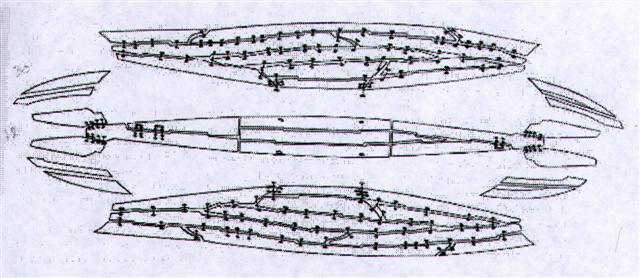
... From Manuscript E [E:91]
we have learned that it was the task of
Nuku Kehu to pound
the staffs with feather garlands into the ground
to mark the boundary of the king ...
...
After all the food supplies had been brought on
land [i oti era te kai te too mai ki uta],
the two rulers [te ariki arurua], the
king and the queen said, 'Drag the canoes on
land and take them apart (so the wood can be
used) to build houses and cover the roofs!'
They dragged the
two canoes on land and took them apart.
After they had finished disassembling the
canoes, Nuku covered all the houses ... [E:84]
Pepe. 1. A sketch. 2. Bench, chair,
couch, seat, sofa, saddle; here pepe,
mau pepe, to saddle; noho pepe, a
tabouret. Pepepepe, bedstead. 3. Pau.:
butterfly. Ta.: pepe, id. Mq.: pepe,
id. Sa.: pepe, id. Ma.: pepe, a
moth; pepererau, fin, Mgv.: pererau,
wing. Ta.: pereraru, id. Ma.: parirau,
id. Harepepe, kelp. Here pepe, to
saddle. Churchill. Sa.: pepe, a
butterfly, a moth, to flutter about. Nukuoro,
Fu., Niuē, Uvea,
Fotuna, Nuguria, Ta., Mq.: pepe,
a butterfly. Ma.: pepe,
a grup, a moth; pepepepe,
a butterfly; pepeatua,
a species of butterfly. To.: bebe,
a butterfly. Vi.: mbèbè,
a butterfly. Rotumā: pep,
id. Churchill 2. Mq.: Pepepepe,
low, flat. Ha.: pepepe, id. Churchill. |
|
VISIBLE CLOSE
TO THE FULL MOON: |
|
Rooftop-12 (Swallow)
22h (334.8)
KAE
UH (Roof) = ο Aquarii
(334.0),
AL
KURHAH (White Spot) = ξ Cephei (334.4),
SADALMELIK
(Lucky King) = α Aquarii,
AL DHANAB (The Tail) = λ Gruis
(334.6), ι Aquarii, ν Pegasi (334.7)
*293.0 = *334.4 - *41.4 |
ι
Pegasi (335.0),
ALNAIR (The Bright One) =
α
Gruis
(335.1),
μ
Piscis Austrini,
υ
Piscis Austrini (335.3),
WOO (Pestle) =
π
Pegasi
(335.7),
BAHAM =
θ
Pegasi (Good Luck of the Two Beasts),
τ
Piscis Austrini (335.8) |
ζ
Cephei (336.2),
λ
Cephei (336.3), -/270 Lac.
(336.7), λ Piscis Austrini (336.8) |
μ
Gruis (337.0),
ε
Cephei (337.2), 1/325 Lac. (337.3),
ANCHA (Hip) =
θ
Aquarii (337.4),
ψ
Oct.
(337.5), α Tucanae (337.9)
*296.0 = *337.4 - *41.4 |
Al Sa'ad al Ahbiyah-23
(Lucky Star of Hidden Things) /
Shatabisha-25 (Comprising
a Hundred Physicians)
ε
Oct. (338.1),
ρ Aquarii
(338.2), 2/365 Lac. (338.5),
SADACHBIA =
γ
Aquarii
(338.6),
π
Gruis (338.9) |
β/172
Lac. (339.2),
4/1100 Lac. (339.4),
π Aquarii
(339.5)
*298.0 = *339.4 - *41.4
CASTOR (α
Gemini)
|
δ
Tucanae (340.1),
ρ
Cephei (340.2),
ν
Gruis (340.3),
ζ
Aquarii,
δ
Gruis (340.4),
5/1100 Lac.
(340.7), σ Aquarii, 6/650 Lac. (340.9)
*299.0 = *340.4 - *41.4
PROCYON (α
Canis Minoris) |
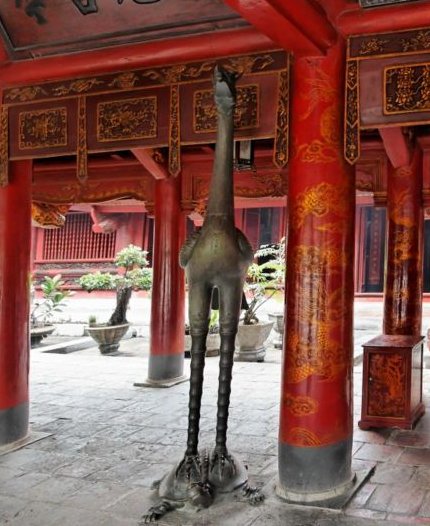
... Horapollo, the grammarian of Alexandria,
about AD 400, tells us that the crane was the
symbol of a star-observer in Egypt
... Grus has as an alternative name
Flamingo (a name which sounds quite similar to
that of the bird Phoenix) which obviously is
based on 'flame'. Phoenicopterus (the
Flamingo) is characterized by its red feathers.
Wikipedia: ... from Greek
φοινικόπτερος
meaning 'purple wing'. Purple is the colour for
kings and 'phoenix' should therefore mean
'purple, the colour of the king' ... |
| Febr 18
(414) |
19 |
20 (*336) |
21 |
22 (447 - 29) |
23 (Terminalia) |
24 (420) |
|
DEC 16 (350) |
17 |
18 |
19 |
20 |
21 (SOLSTICE) |
22 (420 - 64) |
And from there we could then count 414 - 264 = 150 days ahead,
resulting in
22 (Bb1-22) + 150 = 172 (Bb5-9):
|
Jan 17
(355 + 27 = 382) |
18 |
19 (384) |
|
Solstice (382 - 27 = 355) |
'Dec 22 (356 = 382 - 27) |
23 |
|
HELIACAL STARS: |
|
ε Pavonis, θ Sagittarii (302.3), γ Sagittae
(302.5), μ Pavonis (302.7) |
τ Aquilae
(303.8) |
20h (304.4)
304.4 = 118.4 + 186.0
η Sagittae (304.2),
δ Pavonis (304.4)
*263.0 = *77.0 + *186.0 |
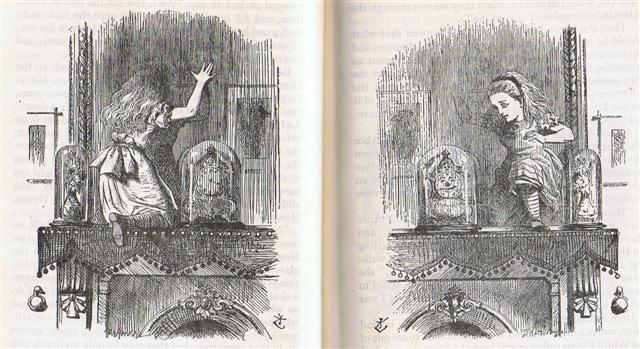
Alice exhibited her upraised
right arm with empty hand when pushing on
from the night side, and at her entrance
into the side of the light she had turned
her hand into a convex form, a pattern
opposite to that of the Mad Hatter:
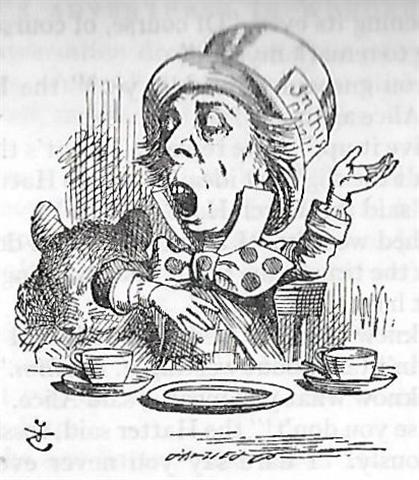
'Twinkle, twinkle, little
bat!' // How I wonder what you're at!' |
 |
 |
 |
|
Bb5-9
(172 → Solstice) |
Bb5-10 |
Bb5-11 (595) |
|
mai tae tuki to haga -
mai tae oho te rima |
mai tae te vere ki te
henua - ko te rima e oho ki to kava |
eko te tagata kua
hakahonui |
|
Rima.
1. Hand, also, but improperly,
fingers, forearm; te ko mu'a o te rima,
palm of the hand; te ko tu'a o te
rima, back of the hand; rima
hakaturu, generous, liberal, munificent;
tagata rima pu'a, helper; rima
hakakau, generous hands, open-handed
person; rima matu'a neanea, thumb. 2.
Fifth; e-rima, ka-rima, five. Vanaga.
1. Five. P Mgv., Ta.: rima, id. Mq.:
ima, id. 2. Arm, hand; rima atakai,
obliging, kind, generous, a gift, rima
tuku, elbow, rima omo,
infidelity, faithless, unfaithful, rima o
te kahu, sleeve, kakari rima,
wrist. P Pau.: rima, hand, arm. Mgv.:
rima, hand, arm, paw, finger. Mq.:
ima, hand, arm. Ta.: rima, arm,
hand, finger. Rimahakaviriviri, fist,
to clench the fist, a blow of the fist.
Rimahati, one-armed. Rima ko manaroa,
little finger T. Rimamatua neanea,
thumb. Rimaroaroa tahaga, middle
finger T. Rimatitiri, to walk with
the hands behind the back. Rimaruru,
to clasp hands. Rimatuhi henna (?)
index finger T. Rimatuhi a hana,
finger ring T (? ring finger). 3. To lead
into error; rimaetua, supernatural,
Mq.: imaima, that which returns after
a man's death, Ta.: rimaatua, plague,
dissension, mortal illness. Churchill.
Honui. 1. Person
worthy of respect, person of authority. 2.
Livelihood, heirloom, capital;
ka moe koe ki toou hônui, you must
marry to ensure your livelihood (said to a
little girl); he hônui mo taaku poki,
this is the heirloom for my son. Vanaga.
Great (hoonui); honui, chief
T.; tagata hoonui, personage;
hakahonui, to praise, to commend.
Churchill. |
|
RIGHT
ASCENSION DAYS AT THE FULL MOON: |
|
DRUS (Hard)
= χ Carinae
(119.9) |
ω Cancri
(120.2) |
8h (121.7)
χ
Gemini (121.0),
NAOS (Ship) =
ζ
Puppis
(121.3) |
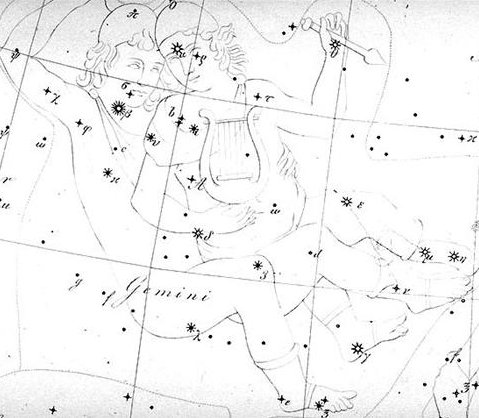 |
|
July 18 (172 + 27) |
19 (200) |
20 |
|
Solstice |
'June 22
(200 - 27 = 173) |
23 |
|
MAY 15
(500) |
16 (136 =
200 - 64) |
17 |
|
... As
has already been mentioned, the Delphians
worshipped Dionysus once a year as the
new-born child, Liknites, 'the Child
in the Harvest Basket', which was a
shovel-shaped basket of rush and osier used
as a harvest basket, a cradle, a manger, and
a winnowing-fan for tossing the grain up
into the air against the wind, to separate
it from the chaff. The worship of the Divine
Child was established in Minoan Crete, its
most famous early home in Europe. In 1903,
on the site of the temple of Dictaean Zeues
- the Zeus who was yearly
born in Rhea's cave at
Dicte near Cnossos, where Pythagoras spent
'thrice nine hallowed days' of his
initiation - was found a Greek hymn which
seems to preserve the original Minoan
formula in which the gypsum-powdered,
sword-dancing Curetes, or tutors, saluted
the Child at his birthday feast. In it he is
hailed as 'the Cronian one' who comes yearly
to Dicte mounted on a sow and escorted by a
spirit-throng, and begged for peace and
plenty as a reward for their joyful leaps
...
 |
Furthermore, from Betelgeuze (*88) to Spica (*202) there were 114
right ascension days, a number which we now will
recognize as belonging in the fundamental sequence:
|
114 |
214 |
314 |
414 |
|
114 + 3 * 314
= 12 * 88 = 1056 = 4 * 264 |
|
 |
*114 |
 |
|
June
17 (168, *88) |
Oct 9
(282, *202) |
|
BETELGEUZE |
SPICA |
 |
 |
 |
 |
 |
 |
 |
|
Bb7-10 (674) |
(248 + 6) |
Bb7-12 (255) |
Bb7-13 |
Bb7-14 |
Bb7-15 |
Bb7-16 (680) |
|
kua moe atu te manu |
ki raro o tona manu
punua |
kua vero koia |
kua moe koia |
i te eve o te manu |
ko te tagata oho ia |
ka oho oia |
|
Punua, burst of thunder.
Nua.
1. Mother; this seems a more
ancient word than matu'a poreko.
2. Blanket, clothing, cape formerly made
from fibres of the mahute tree.
Vanaga. Cloak T. Churchill.
Nu'a
1. Thick; piled one on top of the other,
as leis,
mats, or ocean swells; heaped; lush,
thick-growing; much traveled, as a road;
multitude, as of people, mass. Also
hānu'a.
Moena
kumu nu'a, a sleeping mat
made thick at one end to serve as a head
rest; lit. 'mat piled
beginning'.
Nu'a
moena,
a heap of mats.
Nu'a
kanaka, many people.
Haki
nu'a ka uahi i ke kai, the
spray breaks in masses in the sea.
Ka nu'a o ka palai, the thick
clump of
palai ferns.
Ho'o
nu'a, to heap up; to give
generously and continuously; to indulge,
as a child; surging, rising in swells,
as the sea. 2. A kind of seaweed.
Nu'a-kea, a goddess of lactation.
Wehewehe.
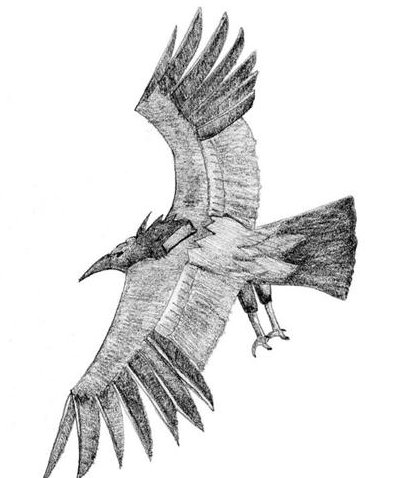
... The Raven stole
the skin and form of the newborn child.
Then he began to cry for solid food, but
he was offered only mother's milk ...
Eve. 1. Placenta,
afterbirth (eeve). T Pau.: eve,
womb. Ta.: eve, placenta. Ma.:
ewe, id. Haw.: ewe, navel
string. 2. The rear; taki eeve,
the buttocks; hakahiti ki te eeve,
to show the buttocks; pupuhi eve,
syringe. 3. The bottom of the sea.
Churchill. |
|
April
8 |
9
(464) |
10
(100) |
11 (466) |
12 |
13 |
14
(104) |
|
No star listed (18) |
ADHIL (Garment's Train) = ξ Andromedae
(19.3),
θ
Ceti (19.7) |
KSORA (Knee) =
δ
Cassiopeiae
(20.1),
ω
Andromedae (20.6),
γ
Phoenicis (20.8) |
δ Phoenicis (21.5) |
υ Andromedae (22.9) |
ACHERNAR (End of the River) =
α
Eridani
(23.3),
χ
Andromedae (23.6),
τ
Andromedae (23.9) |
ALSEIPH (Scimitar) =
φ
Persei
(24.5),
τ
Ceti (24.7) |
|
RIGHT
ASCENSION DAYS AT THE FULL MOON: |
|
Oct 7
(280) |
8 |
9 |
10 |
11 |
12
(285) |
13
(104 + 182) |
|
AUG 4 (*136) |
5
(210 + 7) |
6 |
7 |
8
(220) |
9
(*141) |
10
(104 + 118) |
|
...
It was 4 August 1968, and it was the
feast day of Saint Dominic, patron of
Santo Domingo Pueblo, southwest of Santa
Fe. At one end of the hot, dusty plaza,
a Dominican priest watched nervously as
several hundred dancers arranged in two
long rows pounded the earth with their
moccasined feet as a mighty, collective
prayer [ui] for rain, accompanied
by the powerful baritone singing of a
chorus and the beat of drums. As my
family and I viewed this, the largest
and in some ways the most impressive
Native American public ceremony, a tiny
cloud over the Jémez Mountains to the
northwest got larger and larger,
eventually filling up the sky; at last
the storm broke, and the sky was
crisscrossed by lightning and the pueblo
resounded with peals of rolling thunder
...
 |
|
σ Virginis (200.4)
*159.0 = *200.4 - *41.4 |
γ
Hydrae (201.0),
ι
Centauri (201.4)
*160.0 = *201.4 - *41.4 |
Al Simāk-12
(Lofty) /
Chitra-14
(Bright One) /
Horn-1 (Crocodile)
/
Sa-Sha-Shirū-19
(Virgin's Girdle)
/
ANA-ROTO-3 (Middle
pillar)
MIZAR =
ζ
Ursae Majoris (202.4),
SPICA =
α
Virginis,
ALCOR = 80 Ursae Majoris
(202.7)
SADALMELIK (α Aquarii)
*161.0 = *202.4 - *41.4 |
71 VIRGINIS
(203.6) |
No star listed (204) |
HEZE =
ζ
Virginis
(205.0),
SOUTHERN PINWHEEL GALAXY = M83 Hydrae
(205.7) |
ε Centauri (206.3),
κ Oct. (206.4)
*165.0 = *206.4 - 41.4 |
 |
Punua →
pu-nua (a hole in the cloth or blanket → in the 'sky
garment' - cfr
Parpola).
Nua.
1. Mother; this seems a more ancient word than
matu'a poreko. 2. Blanket, clothing, cape
formerly made from fibres of the mahute
tree. Vanaga. Cloak T. Churchill.
Nu'a 1.
Thick; piled one on top of the other, as
leis,
mats, or ocean swells; heaped; lush,
thick-growing; much traveled, as a road;
multitude, as of people, mass. Also
hānu'a.
Moena kumu nu'a,
a sleeping mat made thick at one end to serve as
a head rest; lit. 'mat piled
beginning'. Nu'a
moena,
a heap of mats.
Nu'a kanaka, many people.
Haki nu'a ka
uahi i ke kai, the spray breaks in
masses in the sea.
Ka nu'a o ka palai, the thick clump
of palai
ferns. Ho'o nu'a,
to heap up; to give generously and continuously;
to indulge, as a child; surging, rising in
swells, as the sea. 2. A kind of seaweed.
Nu'a-kea, a goddess of lactation. Wehewehe.

Betelgeuze was in a kind of hole (when looking
down from the north) and so was Spica (when looking
up from the south):


Order creates progress.
|
.jpg)








.jpg)


























